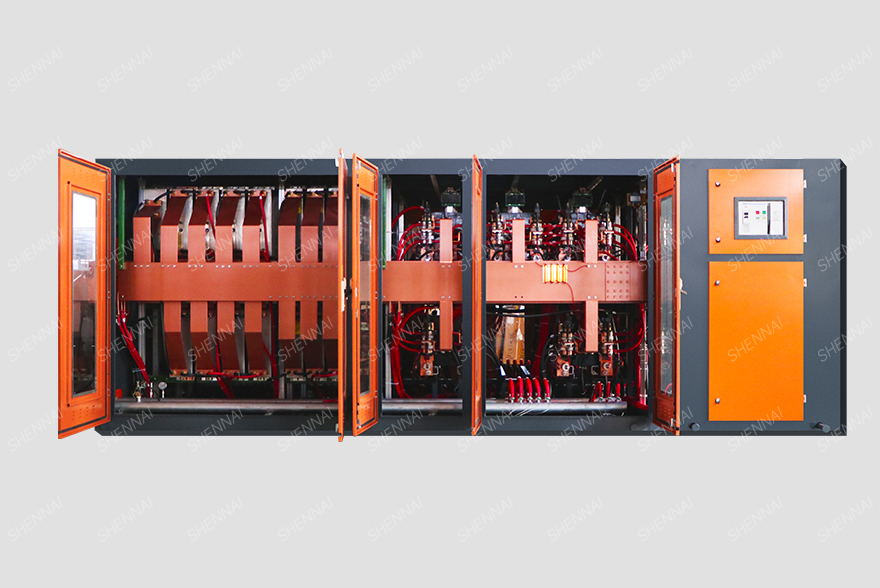- Tel:+8613007564317
- Email:[email protected]
FAQ

Medium frequency induction furnace is widely used because of its advantages of less investment, quick effect and convenient operation. Energy saving in induction furnace production has been concerned by manufacturers. According to the production characteristics of induction furnace and many years of production practice experience, Luoyang shennai Electric Power Equipment Co., Ltd. discusses the ways of power saving in the production of induction furnace of medium frequency furnace from the aspects of improving production efficiency, improving melting speed and reducing melting time.
1. Extend continuous smelting time
The unit consumption of electric energy is closely related to the smelting mode. The working mode of the furnace can be divided into three situations:
1) Continuous smelting: three shifts of continuous operation every day;
2) Intermittent smelting: two or one shifts of operation every day. During non operation, the hot metal in the furnace is insulated with insulation power;
3) Intermittent smelting: it is obvious that the net output is all after the completion of each day. In the above three cases, the unit power consumption of continuous smelting is the lowest, followed by intermittent smelting, and intermittent smelting is the highest. Therefore, centralized and continuous smelting should be arranged as far as possible if conditions permit. Try to increase the number of primary smelting furnaces, extend the continuous smelting time and reduce power consumption. The total tonnage of molten iron that can be expected to reach within the service life cycle of silicon lining is evaluated according to the following empirical formula: n=k (g2l) 1/3
Where: Ⅳ_ I. total tonnage of molten iron, t; GL - furnace capacity, kg;
K - constant; Melt the cold material once a day, k=l_ 3~l 8; Melt the cold material once a week (6-7 hours per day), k=2.8-4.6:
Melt the cold material once a week (work for more than 18h every day). K=6.0-9.0
It can be seen from the above formula that when the furnace capacity is certain, n is proportional to K, that is, the longer the melting cycle of the cold furnace is, the larger the Ⅳ is, the longer the furnace life is, and the lower the material consumption and energy consumption per ton of molten iron are Taking the intermittent smelting of 1.5T cast steel as an example, the smelting time is about 100min for the first cold furnace smelting time. Then the hot furnace smelting time is about 80 mln, and the cold furnace smelting time is 30 minutes longer than the hot furnace smelting time. If 60% power is used for heating during this period, which is equivalent to 100% power for 18min, then when 5 heats are smelted at a time, the total smelting time is about 422 MLR, and the multi-purpose cold furnace smelting time accounts for 18 / 422=4.2%, when 10 heats are smelted at a time, The total smelting time is about 722 min. the multi-purpose time of cold furnace accounts for 18/722=2 4%。 In comparison, the time of using 10 heats of one smelting furnace more than 5 heats of one smelting furnace is reduced by 18%, that is, the electric energy can be saved by 18%. A continuous smelting furnace has many times and takes a long time. When the output is certain, the number of cold furnace smelting is less. There is less chance of cracking of the furnace due to the high and low temperature, which is also conducive to extending the life of the furnace lining.
2. Reasonable ingredients
The scientific management of furnace charge is of great significance to improve the production efficiency of medium frequency induction furnace and reduce energy consumption. First of all, it is necessary to master the chemical composition of all kinds of furnace charge, and carry out careful and reasonable burden calculation. By using the reasonable collocation of all kinds of furnace charge, we can make sure that the main chemical composition in the molten steel meets the requirements, the content of harmful impurity elements is as little as possible and does not exceed the standard, avoid delaying the smelting time due to adjusting the composition, and prevent the scrap of molten steel due to unqualified composition, increasing material consumption and power consumption. Therefore, the furnace charge must be properly classified according to the chemical composition, impurity content and block size, cut large and long scrap, and package light and thin materials if possible, so as to ensure smooth charging and reduce smelting time. The size of the lump size of the furnace charge should be compatible with the power frequency. The power frequency used by the induction furnace decreases with the increase of the furnace capacity. Therefore, the large capacity induction furnace can use large charging, and the small capacity induction furnace can use small charging.
The distribution of induced current in the polymetallic conductor obeys the skin effect. The induced current in the charge and molten steel is subject to the skin effect, which decreases from the surface to the center. The distance from the point where the current intensity is reduced to 368% of the surface current intensity to the surface of the conductor is called the current penetration depth. The induced current in the charge is mainly concentrated in the penetration depth layer, and the heat of the reinforced hot charge is mainly supplied from the surface layer. In order to make the whole cross section of the charge get the same temperature, with the extension of heating time, the heat lost by the charge to the surrounding medium increases, so the thermal efficiency decreases. If the penetrating depth layer is properly matched with the geometric size of the charge, the heating time is short and the thermal efficiency is high.
The research on cylindrical metal materials shows that the total efficiency is the highest when the ratio of cylindrical diameter D to penetration depth △ I is 35.
We will get in touch with you as soon as possible
